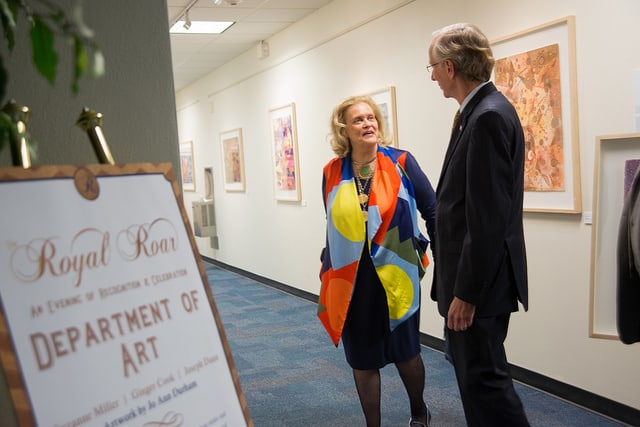It’s a Wonderful Life

“My grandmother took me out into a field to paint bluebonnets,” alumna and decorated artist Jo Ann Durham tells me as I follow her into her studio. “My grandmother is the one who got me started. All of this is because of her.” All of this includes a wall of honors, prize ribbons, and even an honorary doctorate from an art academy in Belgium.
Jo Ann talks about her life like someone who is just now considering how astonishing it is. She's surprised and pleased. “I never dreamed I would have such a wonderful life.” She shows me her most famous piece, “Angel of Faith and Hope” (1997), a work born from the pain of losing her 24-year-old son, John. The painting was featured on the cover of Manhattan Arts Magazine and was included in the book “Art and Healing” by Barbara Ganim (1999). Over the past 14 years, Jo Ann has received hundreds of requests to use the image, mostly from parents who have lost children. Of course, many of those parents write back to her.
“I have a whole file cabinet full of them,” Jo Ann tells me, handing me a small bundle of cards and handwritten letters. This one is from Columbine. Another is from New York, marked 2001. With each print, Jo Ann includes a note about her son and about the origin of the painting. In it, she says, “Death is not the end. It is the doorway to Heaven where we will all be reunited.” She has produced a huge basket full of stacks and stacks of Christmas cards, and says, “I send these out, too. Every year, I send over 200.”
Jo Ann recently donated a collection of her paintings to the university, another way for her to give back. “I'm 78 now,” she says, “I just can't keep all of this, and I'm so happy to still be painting. I'm like any artist. I want people to see my work… it's a legacy.” One piece was part of the silent auction for the 2013 Royal Roar.
She is an experimental artist. When she was an artist-in-residence with the Texas Commission on the Arts, she started working with encaustic sets and began to combine the technique with water-based media. She uses hot wax to save white space while she paints. She layers inks, metallic powders and finally goes back in with colored wax. “I use a pointillist approach,” she says. “It takes hours,” but she has infinite patience. She has given me and Jared Horn (our photographer) hours of her day… and lots of coffee. You feel important when you are with her.
Before we leave, she takes out an East Texas State yearbook. It's from 1956. “I was part of the Tooanoowe Social Club,” Jo Ann points to her 1956-self with a large painting in the background. “I did this painting for a dance and dinner. The guys said if I did it, they would get me a date.” It's the perfect way to end, on a light and sincere note. Jared and I laugh at the story. She gives us both a few cards from Christmases past, a final, thoughtful gesture.
Jo Ann Durham says she has an “intense delight” in her work and her life. It's the kind of perspective we could all use going into a new year.


